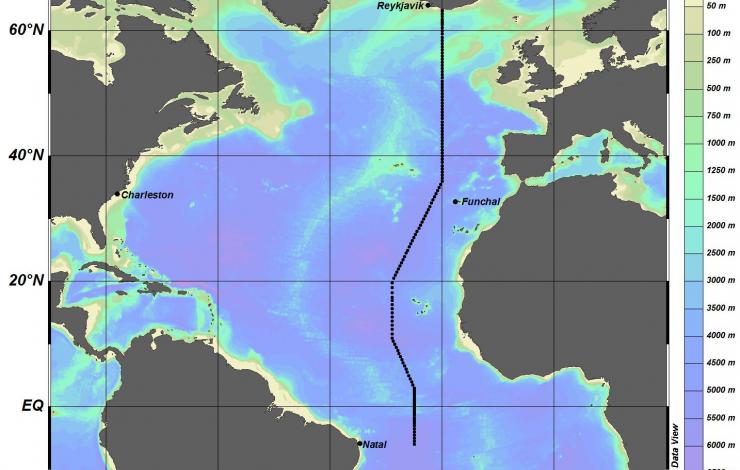What's New Archive
Researchers at PMEL and JISAO are monitoring an area of warm surface water that has been occupying the Northeast Pacific near Ocean Climate Station Papa buoy. This mass of water, nicknamed “The Blob”, was about 3 degrees Celsius warmer than normal in February and is maintaining its abnormal heat into the summer. The warm water has implications for the marine ecosystem and could affect the weather in the Pacific Northwest. Past summers with especially warm water off the coast have tended to be warmer and more humid than usual.
To check out the latest conditions with The Blob, visit the Ocean Climate Station Papa buoy page.
PMEL’s Dr. Trish Quinn led a group of PMEL and JISAO scientists on a recent cruise in the North Atlantic Ocean to assess how ocean biogeochemistry impacts sea spray particles. Quantifying the size and composition of sea spray particles is critical for parameterizing cloud condensation nuclei in climate models. The particles are generated using the PMEL developed Sea Sweep device that is deployed over the side of the ship to collect samples.
The study, which ended on June 5, is part of the Western Atlantic Climate Study II (WACS II) and was conducted using the Woods Hole Oceanographic Institute’s R/V Knorr. For more information please visit PMEL’s Atmospheric Chemistry website.
PMEL and Alaska Fisheries Science Center’s EcoFOCI program just deployed the M2 mooring in the southeastern Bering Sea for the 20th consecutive year. The mooring has been providing year-round measurements of temperature, salinity, nitrite, chlorophyll, and currents in this highly productive area since 1994. These measurements are used in annual report cards and stock assessments provided to the North Pacific Fishery Management Council. Long-term time-series at this site are a critical tool for adapting to climate change and guiding sustainable management of living resources in the Bering Sea.
Visit the EcoFOCI website for more information on their work in the Bering Sea, Gulf of Alaska, and Arctic waters.
PMEL carbon scientists Drs. Nina Bednarsek and Richard Feely were part of a NOAA-led team to find the first evidence that acidity of continental shelf waters off the West Coast dissolving the shells of pteropods. Their research, published April 30 in the Proceedings of the Royal Society B, estimates that the percentage of pteropods in this region with dissolving shells due to ocean acidification has doubled since the pre-industrial era and is on track to triple by 2050 when coastal waters become 70 more corrosive due to human-caused ocean acidification.
Read more on the NOAA press release and the PMEL Carbon Group ocean acidification page.
NOAA Arctic Program Leads, including PMEL scientist and Arctic expert Dr. James Overland, collaborated on the development and recent publication of NOAA's Arctic Action Plan. The plan provides a roadmap to making shared progress in monitoring, understanding, and protecting the vulnerable Arctic region. PMEL is actively involved in Arctic climate dynamics research, conducting observations and evaluating models of Arctic sea ice to document and predict climate change impacts on Arctic marine ecosystems.
Find out more on the NOAA Arctic theme page and PMEL Arctic research web pages.
The Bering Sea Project, a 6-year multidisciplinary program encompassing the work of more than 100 collaborating scientists, has led to major new understanding of the role of sea ice and changing climate in one of the world’s most commercially viable fisheries. The timing of spring sea ice retreat influences large zooplankton yields, an important prey species, and impacts pollock recruitment in the Bering Sea Fisheries.
Results were presented at the Bering Sea Open Science Meeting and EcoFOCI’s major contributions to the program are published in a series of Headline Articles and Deep Sea Research II special issues.
Immediately following a magnitude 8.2 earthquake off the coast of Chile on April 1, scientists at PMEL began modeling the event using real-time data from DART® moorings that measured the tsunami 30 minutes after the earthquake struck. They accurately predicted wave arrival times and heights for US coastal communities like Hilo, Hawaii, where a tide gauge recorded a 50 cm tsunami wave.
Please visit the Chile tsunami event page for more information, including tide gauge comparisons with model data for other communities.
Research published recently in Global Biogeochemical Cycles describes how observations in the tropical Pacific now show human activity is contributing to increasing CO2 levels where, previously, natural variability has dominated ocean CO2 patterns. Lead author, PMEL/JISAO scientist Adrienne Sutton, along with PMEL’s Dr. Richard Feely also conclude that the rates of CO2 and acidity in seawater are just as rapid in the tropical Pacific as in polar regions, which are considered one of the harbingers of ocean acidification.
To read more please visit the NOAA Research news page.
In a paper published recently in Nature Geoscience PMEL Atmospheric Chemistry group, led by Dr. Patricia Quinn, and others show that the organic carbon content of sea spray aerosol (produced by breaking waves on the ocean surface) was similar in all regions sampled, regardless of the presence or absence of plankton blooms. Previously, all large scale climate models have used chlorophyll-a, a proxy for plankton biomass, to predict the organic carbon content of sea spray aerosol. This study concludes that this method will lead to inaccurate predictions.
For more information on this study please visit the Nature Geoscience website to download the full paper.
From August 2013 to February 2014, PMEL scientists and technicians from multiple groups participated in an Atlantic Ocean survey of the A16 line from 63°N near Iceland to 63°S near Chile on the NOAA Ship Ronald H. Brown. In total, 258 full water column stations were sampled over 100 days at sea along the section, making a variety of physical, chemical and biological measurements. The data collected on this expedition will be compared with earlier data sets from previous decades to detect changes in ocean properties.
You can find more information about this expedition by visiting the A16N and A16S web pages.










